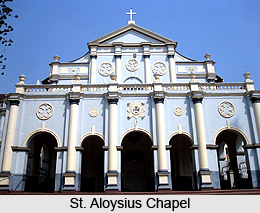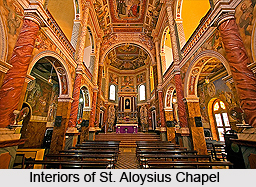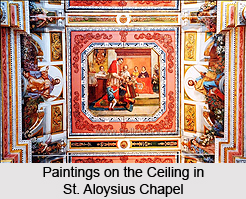 St. Aloysius Chapel, located at the central region of the city on a hill, well-known in the region as the Lighthouse Hill, was built by Reverend Father Joseph Willy. This Christian chapel was built in 1884, as a part of the Mangalore Mission started in 1878. Owing to their focus on the education, health and social welfare of the Mangalorean Catholic Community, the Italian Jesuits built the St. Aloysius College in 1880 and St. Aloysius Chapel in 1884.
St. Aloysius Chapel, located at the central region of the city on a hill, well-known in the region as the Lighthouse Hill, was built by Reverend Father Joseph Willy. This Christian chapel was built in 1884, as a part of the Mangalore Mission started in 1878. Owing to their focus on the education, health and social welfare of the Mangalorean Catholic Community, the Italian Jesuits built the St. Aloysius College in 1880 and St. Aloysius Chapel in 1884.
Walls of the chapel are adorned with a number of paintings, which are the works of the famous Italian Jesuit painter Antonio Moscheni. The chapel is spectacular with some magnificent paintings on the ceiling, fresco painting and oil canvas paintings. Constructed to pay homage to the famous personality of Aloysius Gonzaga, the chapel contains several paintings associated with the Apostles, the Church saints, Jesuit saints and Life of Jesus.
History of St. Aloysius Chapel
The St. Aloysius Chapel in Mangalore was built by Jesuit Missionaries in 1880 and its interiors painted by the Italian Jesuit Antonio Moscheni in 1899, during the Mangalore Mission in 1878. The Italian Jesuits played an important role in education, health, and social welfare of the Mangalorean Catholic community and built the St. Aloysius College in 1880, St Aloysius Chapel in 1884, and many other institutions and churches.
Architecture of St. Aloysius Chapel
St. Aloysius College Chapel is an architectural marvel. It is unique in a way that it has all beautiful paintings that almost cover every inch of the walls. Bro. Moscheni from Italy is the creator of this master piece. One portion of the chapel paintings depicts the life of Saint Aloysius Gonzaga to whom Aloysius College and chapel are dedicated. It has well decorated interiors.
Paintings in St. Aloysius Chapel
 His earlier life is shown in the first three panels from the rear. Some of the paintings are:
His earlier life is shown in the first three panels from the rear. Some of the paintings are:
•Aloysius as a child promising at the Altar of Mary in Florence to dedicate his life to God.
•Aloysius preaching about God to his townsfolk.
•The first communion of Aloysius.
•Aloysius seeking admission to the Jesuit Order.
The rest of his life is depicted on the wall which is above the altar. The central picture depicts him serving the people who were suffering from plague in Rome. Apostles are portrayed on the panels of the sloping portion of the ceiling. The Series of the Upper Arches depict the saints of the Church. The lower arches depict Jesuit saints.
Some of those paintings are:
•St. Thomas, Apostle of India, with a spear in his hand is on the 3rd left panel.
•St. Francis of Assisi, Patron of Environmentalists is on 3rd right arch.
•St. Peter Claver, the Apostle of the Negroes, who served the slaves when they arrived in Cartagena, making them feel through his care and love that they were his equals is on 4th left arch.
•Bl. Rudolf Aquaviva who had gone to the Court of Akbar, and was there held in high esteem.
•St John De Britto, the first missionary to wear the dress of a sanyasi. He was a scholar who studied Sanskrit and Tamil languages and Indian customs.
 Fresco and canvas are two types of paintings in the Chapel. A fresco is painted on fresh wet lime plaster walls. Frescos cover about 600 square metres of the walls of the Chapel. The canvas is made of pure linen of strong close weave. The paintings on the ceilings in the Chapel which covers about 400 square metres are in oil on canvas. Antonio Moscheni took a little over 2 years to cover the walls and ceilings of the Chapel with paintings.
Fresco and canvas are two types of paintings in the Chapel. A fresco is painted on fresh wet lime plaster walls. Frescos cover about 600 square metres of the walls of the Chapel. The canvas is made of pure linen of strong close weave. The paintings on the ceilings in the Chapel which covers about 400 square metres are in oil on canvas. Antonio Moscheni took a little over 2 years to cover the walls and ceilings of the Chapel with paintings.
Restoration of Paintings in St. Aloysius Chapel
It is considered to be the masterpiece of Moscheni. Due to seepage of rain water the painting was covered with fungus and calcium carbonate crystals. It has now been restored but a patch of the unrestored painting has been left untouched below the woman seated at the right.











